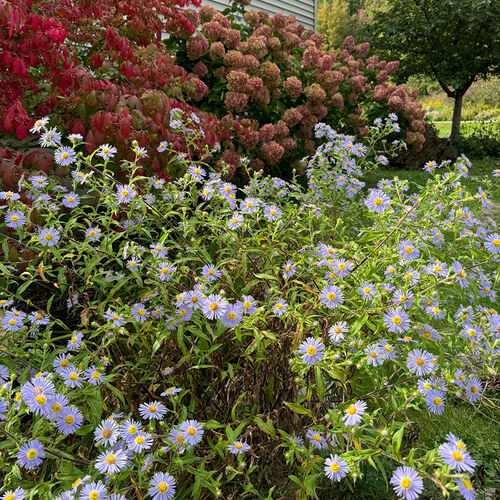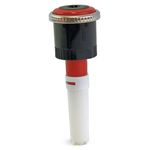
Hi GPODers!
Today we’re getting an update from Jane Watkins in upstate New York. Jane has shared her garden a few years in the past (check out those submissions: A Colorful Perennial Garden, Finding Plants That Work, and Spring After a Hard Winter), but today we’re getting a glimpse of her garden as it transitions to autumn and the many pinks and purples of the season are on display.
My name is Jane and I garden in central upstate New York, near the Finger Lakes in zone 5b. I’ve been gardening in this location nearly 40 years. I am a Master Gardener through Cornell Cooperative Extension and enjoy working with my fellow gardeners as well as in my own gardens. My challenges are heavy clay soil full of rocks (although they make great stone garden walls) and a voracious deer population. I protect some plants, like hardy hibiscus, with deer netting and plan to move them next spring to a more protected semi-fenced location in my back yard. I also drape deer netting over my clematis. I try not to use too much of this because I don’t want birds or chipmunks getting tangled in the netting. For other deer snacks, like phlox and Asiatic lilies, I “hide” them behind minty monarda or short grasses. I store the dahlia tubers in coolers filled with wood shavings. The Grandpa Otts morning glories were started decades ago and self-sow everywhere. I start the zinnias indoors under grow lights. Everything else is a hardy perennial.
In late summer, Jane’s garden is an explosion of color with bursts of coneflowers and black-eyed Susans (Rudbeckia hirta, Zones 3–9). While pink often isn’t the first color we think of when scenes of autumn come to mind, it is a color that pairs so well with the other colors of the season like yellow, orange and even red.
 A close up of those beautiful purple coneflower (Echinacea purpurea, Zones 4–9) with a red switchgrass behind, creating another sensational combination.
A close up of those beautiful purple coneflower (Echinacea purpurea, Zones 4–9) with a red switchgrass behind, creating another sensational combination.
 The ‘Grandpa Otts’ morning glories (Ipomoea purpurea ‘Grandpa Ott’, annual) Jane mentioned above. As she also mentioned, these beauties can self-sow very easily and can often take over a garden if left to its own devices. There is hot debate whether morning glories like this are simply invasive or just aggressive. Either way, if you decide to add one to your garden, be cautious where you plant and try to remove most seed pods before they have the chance to travel across your neighborhood.
The ‘Grandpa Otts’ morning glories (Ipomoea purpurea ‘Grandpa Ott’, annual) Jane mentioned above. As she also mentioned, these beauties can self-sow very easily and can often take over a garden if left to its own devices. There is hot debate whether morning glories like this are simply invasive or just aggressive. Either way, if you decide to add one to your garden, be cautious where you plant and try to remove most seed pods before they have the chance to travel across your neighborhood.
 Another pink beauty with a tendency to get weedy in some areas, Japanese anemone (Anemone hupehensis var. japonica, Zones 5–7) always surprises me with how delicate a late-blooming flower can be. If I didn’t know better, I would absolutely guess this is a picture from a spring garden.
Another pink beauty with a tendency to get weedy in some areas, Japanese anemone (Anemone hupehensis var. japonica, Zones 5–7) always surprises me with how delicate a late-blooming flower can be. If I didn’t know better, I would absolutely guess this is a picture from a spring garden.
 Another pink bloom that brings an early-spring vibe to the late-season garden. Creeping phlox (Phlox subulata, Zones 2–8) are a tried-and-true sign of spring, while many other phlox varieties like this gorgeous garden phlox (Phlox paniculata, Zones 4–8) keep the bright blooms going all summer and sometimes into the fall.
Another pink bloom that brings an early-spring vibe to the late-season garden. Creeping phlox (Phlox subulata, Zones 2–8) are a tried-and-true sign of spring, while many other phlox varieties like this gorgeous garden phlox (Phlox paniculata, Zones 4–8) keep the bright blooms going all summer and sometimes into the fall.
 Of course, we can’t talk about floral starts of the late summer/early fall garden without talking about dahlias (Dahlia spp. and cvs., Zones 8–11). Jane has a fabulous mix going on here. I believe the large pink variety towering above the rest is ‘Otto’s Thrill’, the smaller peach/pink: ‘Linda’s Baby’, and the deep magenta could be ‘Le Baron’.
Of course, we can’t talk about floral starts of the late summer/early fall garden without talking about dahlias (Dahlia spp. and cvs., Zones 8–11). Jane has a fabulous mix going on here. I believe the large pink variety towering above the rest is ‘Otto’s Thrill’, the smaller peach/pink: ‘Linda’s Baby’, and the deep magenta could be ‘Le Baron’.
 And it’s not fall without foliage, but this Northern Exposure™ heuchera is channeling the vibes of Halloween rather than Thanksgiving. Jane had it labeled as the Silver variety of this series (Heuchera x ‘TNHEUNES’, Zones 3–10), though it’s looking more like the purple to me (Heuchera x ‘TNHEUNEP’, Zones 3–10). Lighting can have a huge impact on how colors and even texture looks in an image, so forgive me if you ever spot a mislabeled plant!
And it’s not fall without foliage, but this Northern Exposure™ heuchera is channeling the vibes of Halloween rather than Thanksgiving. Jane had it labeled as the Silver variety of this series (Heuchera x ‘TNHEUNES’, Zones 3–10), though it’s looking more like the purple to me (Heuchera x ‘TNHEUNEP’, Zones 3–10). Lighting can have a huge impact on how colors and even texture looks in an image, so forgive me if you ever spot a mislabeled plant!
 These spires of lovely lavendar/pink blooms were new to me! Obedience plant (Physostegia virginiana, Zones 3–9) gets its name from those snapdragon-esque flowers (though the plant is actually a part of the mint family), which will “obediently” stay in whatever position you point them in.
These spires of lovely lavendar/pink blooms were new to me! Obedience plant (Physostegia virginiana, Zones 3–9) gets its name from those snapdragon-esque flowers (though the plant is actually a part of the mint family), which will “obediently” stay in whatever position you point them in.
 While a sensational staple of summer, many hardy hibiscus are long blooming and will carry right on to the end of the season. Summerific® ‘Berry Awesome’ hibiscus (Hibiscus ‘Berry Awesome’, Zones 4–9) packs a big punch with those beautiful, bright pink blooms, but does double-duty with its equally interesting and moody foliage.
While a sensational staple of summer, many hardy hibiscus are long blooming and will carry right on to the end of the season. Summerific® ‘Berry Awesome’ hibiscus (Hibiscus ‘Berry Awesome’, Zones 4–9) packs a big punch with those beautiful, bright pink blooms, but does double-duty with its equally interesting and moody foliage.
 Another beauty that will take you from the heat of summer right through to cool fall days. New England asters (Symphyotrichum novae-angliae, Zones 4–8) is the fillier cousin to New York aster, and it’s paired with a pink accent of sweet peas (Lathyrus odoratus, annual).
Another beauty that will take you from the heat of summer right through to cool fall days. New England asters (Symphyotrichum novae-angliae, Zones 4–8) is the fillier cousin to New York aster, and it’s paired with a pink accent of sweet peas (Lathyrus odoratus, annual).
 If there ever was a combination that proves pink and purple belong in your fall color palette, it’s this one. Professor Kippenberg New York asters (Symphyotrichum novi-belgii ‘Professor Kippenberg’, Zones 4–8) create a drift of periwinkle-blue blooms, while Little Lime® panicle hydrangeas (Hydrangea paniculata ‘Jane’, Zones 3–8) are showing off their rusty-pink fall color, and burning bush (Euonymus alatus, Zones 4–9) is bringing the heat with bright red foliage.
If there ever was a combination that proves pink and purple belong in your fall color palette, it’s this one. Professor Kippenberg New York asters (Symphyotrichum novi-belgii ‘Professor Kippenberg’, Zones 4–8) create a drift of periwinkle-blue blooms, while Little Lime® panicle hydrangeas (Hydrangea paniculata ‘Jane’, Zones 3–8) are showing off their rusty-pink fall color, and burning bush (Euonymus alatus, Zones 4–9) is bringing the heat with bright red foliage.
![]() Jane’s final late-season stunner is this silver Beacon lamium (Lamium maculatum ‘Beacon Silver’ , Zones 4–8). One of several examples Jane has in her garden that showcase how flowers are fabulous but foliage should never be forgotten.
Jane’s final late-season stunner is this silver Beacon lamium (Lamium maculatum ‘Beacon Silver’ , Zones 4–8). One of several examples Jane has in her garden that showcase how flowers are fabulous but foliage should never be forgotten.
Thank you for showcasing all of these incredible plants, Jane! Your garden seems to be doing everything but slowing down.
If your garden is showing off some fabulous fall color now (even if it’s everything but the traditional color palette), we would love to see it. Follow the directions below to submit your photos.
Have a garden you’d like to share?
Have photos to share? We’d love to see your garden, a particular collection of plants you love, or a wonderful garden you had the chance to visit!
To submit, send 5-10 photos to [email protected] along with some information about the plants in the pictures and where you took the photos. We’d love to hear where you are located, how long you’ve been gardening, successes you are proud of, failures you learned from, hopes for the future, favorite plants, or funny stories from your garden.
Have a mobile phone? Tag your photos on Facebook, Instagram or Twitter with #FineGardening!
Do you receive the GPOD by email yet? Sign up here.
Fine Gardening Recommended Products

Hunter Industries MP-1000-90 Hunter Nozzle
– 8′ to 15′ radius with an adjustable arc of 90° to 210°, radius can be reduced by up to 25% to fit landscape needs
– Double-pop technology flushes the nozzle during start-up and shutdown to prevent clogging
– Wind-resistant, multi-directional streams provide even coverage

XLUX Soil Moisture Meter
– Large and clear dial, including ten scales, plug and read
– Simply insert the moisture meter into soil and you’ll get the test result instantly
– Single probe, less hurts to the roots, doesn’t dig up too much soil after test

Dramm Revolution Adjustable 9-Pattern Metal Hose Nozzle
– 15 x 10 x 7 inches
– Ergonomic insulated grip
– Maximum pressure of 90 PSI
– Fully adjustable spray pattern
– No trigger lock





